  |
SWORD TERMS
FITTINGS
All articles other than the blade itself are called KOSHIRAE. When addressed individually or as sets, fittings or "furniture" are called KODOGU.
An outfitted sword has a TSUKA handle, TSUBA sword guard, and SAYA scabbard.
The TSUKA consists of wood, covered with SAME, belly skin of a manta ray, and wrapped with TSUKA-ITO "handle wrapping" braid. The TSUKA KOSHIRAE are the FUCHI-KASHIRA and MENUKI.
  |
The TSUBA is separated on either side by SEPPA. The whole rests against the HABAKI. The HABAKI is meant to secure the blade in the SAYA.
The HABAKI, SEPPA, TSUBA and TSUKA are held on the blade by the taper pin, MEKUGI. The MEKUGI is placed in the MEKUGI-ANA pin-hole.
The mouth of the SAYA, scabbard is called the KOI-GUCHI. The KURIKATA is the knob-shaped cord fixture which may have SHITOTOME (metal collet rings) affixed. The cord is called SAGE-O and the side hook, the SAGURI. The KOJIRI is the end of the SAYA.
The utility knife found in the pocket of the SAYA is the KODZUKA "small handle." The blade within is a KO-GATANA. There may be a similar device called KOGAI (hair arranger) found in a second pocket.
| Sword mounts: | - TACHI A slung sword worn edge down - KATANA Worn edge up in the sash - blade over 2 SHAKU - 24" - TANTO Dagger - blade under 1 SHAKU (12") - WAKIZASHI "Companion Sword" - blade between 1 and 2 SHAKU |
A DAI-TO "long-sword" can be paired with a SHO-TO "short-sword" and called, DAI-SHO. DAI-SHO might consist of matched fittings, matched blades, or both.
 |
BLADES
Every aspect of the blade was created and prided by swordsmiths as personal style.
The classic appraisal view, taken for centuries, has become a technical necessity:
The blade is held straight in the air, at full arm extension, cutting edge to the left. During observation, the blade area nearest the tang, is considered as "lower," while the area toward the point is called "upper." The lower and upper is examined at appraisal (covered in the APPRAISAL OF BLADES) by casting the eye from the base notches slowly to the point, turning the sword, cutting edge to the right, and slowly from the point to the base.
The body of the sword blade is the JI. The tang is NAKAGO.
 |
The cutting edge is the HA. The backridge is the MUNE. The backridge of the NAKAGO is the NAKAGO-MUNE.
The shape and height of ridge lines is pertinent to style. MUNE are seen made three sided MITSU-MUNE, round MARU-MUNE), flat HIRA-MUNE, and the more normal IHORI-MUNE or single ridged.
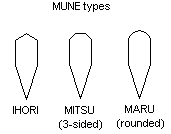
The cutting edge at the tip is the FUKURA. KISSAKI, sword tip, mainly refers to the plane of the sword tip bounded on one side by the FUKURA.
The plane that supports the cutting edge is called the JI.
The plane that supports the MUNE is called the SHINOGI-JI and the ridge line between the MUNE and the HA is called the SHINOGI.
The first six inches from the tip area is known as the MONOUCHI "stroking part" or cutting section. This area is of the highest importance because it was structurally the most difficult to make and it also had to withstand any abuse. The greatest care and effort went into the creation of the MONOUCHI section.
The lines enclosing the KISSAKI are called the KO-SHINOGI and the YOKOTE.
The notches at the NAKAGO are called MACHI. HA-MACHI on the HA, MUNE-MACHI on the MUNE.
NAKAGO
NAKAGO have a variety of shapes, each an adopted style specific to individual smiths.
 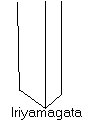   
|
     
|
File marks were individually adopted style patterns as well and are called YASURI. The bottom of the NAKAGO is the JIRI and its variety is also associated with style.
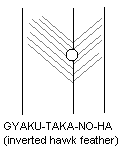








|
SHAPE and MEASUREMENT
One of the most important aspects in appraisal is blade shape or SUGATA (see APPRAISAL OF BLADES - KOTO). While actually taking measurements is not specifically necessary in private ownership, the following terms are always used in descriptions of swords.
KISSAKI are thought of as categorized into three sizes:
| O-KISSAKI CHU-KISSAKI KO-KISSAKI |
- Large or long KISSAKI - Medium KISSAKI - Small KISSAKI |
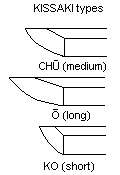 |
The sweep of the FUKURA is then observed as being full, swelling or slender "Withering Fukura".
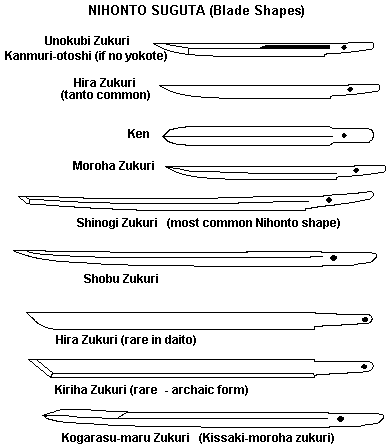 |
Another form of KISSAKI is known as IKUBI or "Boar's Neck." This type has a normal width at the YOKOTE but a relatively small distance from the YOKOTE to the point.
The length of the sword, NAGASA, is always measured from the point to the backridge notch MUNE-MACHI. The length of the NAKAGO - NAKAGO NAGASA is measured from the MUNE-MACHI to the JIRI.
 |
The SORI, or curvature, is measured by noting the greatest distance to be found between the back of the blade and a straight line from the sword point to the MUNE-MACHI.
The type of SORI is noted by recognizing symmetry of curvature. An appraiser will fix the depth of curvature, in the manner mentioned above, as residing on either third or the center of the length.
| MUSORI TORIIZORI KOSHIZORI SAKIZORI TAKENOKO UCHIZORI |
- No curve - Like a "TORII Gate" - even curvature - Curve at the "Waist" - first third from NAKAGO - "Point curve" - curve at point or upper third - "Bamboo sprout" - inward MUNE, usually TANTO - Inward curve (inverse curve) |
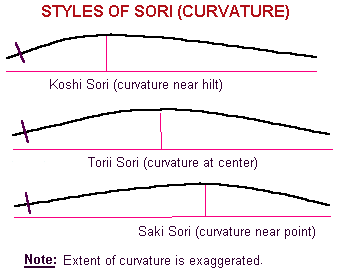
The blade width (MI-HABA) is measured at the KISSAKI from the MUNE across the YOKOTE SAKI-HABA, and at the MACHI from the HA to the MUNE - MOTO-HABA. If only one figure is to be given, it would be MOTO-HABA.
Note: Sword descriptions use "narrow" and "wide" to address measurements between the HA and MUNE.
The blade thickness, or KASANE, is measured at the YOKOTE and at the MACHIs - MOTO-KASANE.
Note: Descriptions use "thick" or "thin" for measurements between ridgelines.
The width of the SHINOGI-JI and the height of the SHINOGI ridge, or blade thickness at the SHINOGI, is noted. A raised SHINOGI, SHINOGI-TAKA, is an appraisal-point.
SIGNATURE
The signature, or MEI, will be found on the OMOTE or "signature side." The reverse of the O-MOTE is the URA.
The signature of a sword is found on the side of the NAKAGO that was meant to face from the body when worn. If the sword was worn edge up, through the sash, the sword is a KATANA and the OMOTE will be signed KATANA-MEI.
Likewise, a sword slung from the belt and worn edge down is known as a TACHI and will be signed on the opposite side of the NAKAGO from that of a KATANA, in TACHI-MEI.
Dates are usually affixed on the URA.
 |
BLADE STYLE
The following is a list of the different sword body styles that might
be encountered.
| KEN - RI-KEN - HO-KEN - SHINOGI-TSUKURI - HIRA-TSUKURI - SHOBU-TSUKURI - OSORAKU-TSUKURI - MOROHA-TSUKURI - NAGINATA - |
Straight body style
Six plane straight sword Two plane straight sword Normal style with SHINOGI ridge Second most common - ridgeless "Iris Leaf" Ridge extends from the point - no YOKOTE Usually a short sword with YOKOTE in the middle of the blade Double-edged sword body Sword with one side beveled to the cutting-edge "Cut-edge" - Both sides beveled "Head of a Cormorant"NAGINATA-like "Lost Crown" - NAGINATA-shaped, having little meat supporting the MUNE. Resembles U-no-KUBI with YOKOTE Halberd with special backridge Long and halberd-like - no YOKOTE Spear |
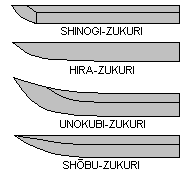 |
BLADE STRUCTURE
Japanese swords were made of laminates. Laminate structure was used to create a synergism of differing elements.
Folding carbon into iron creates steel. Making good metal by hand, however, is an art. Artist's hands created these steels. A good smith applied his art to each laminate planned for the sword body structure.
Hard steel holds an edge but is brittle and will shatter. Soft steel (comparatively lead-like) will never hold an edge but with it, one could beat a road through a mobbed army and not worry about breakage.
Soft stays together, hard holds an edge.
Various laminate structures of hard and soft steel were married in every conceivable way. Usually in certain basic configurations:
| KOBUSE | Two piece. Hard steel wrapped around a center of soft |
| SAN-MAI | Three piece. A center strip of one or more laminates sandwiched between skin steel |
| GO-MAE | Five layer sandwich of laminates |
cross-section of blade picture
sword structures |
The folding pattern or grain is called HADA. Differing grades of steel were folded separately and each laminate may have its own pattern. It is common for polishers to leave the JI plane unburnished to reveal the grain in that area. The revealed grain is referred to as JI-HADA.
The pattern of the HADA is that of the exposed laminate. When made in such a way, the variation of pattern exposes the laminate sandwiching structure; often a straight-grain is seen flowing along the cutting edge, or along the SHINOGI, or the MUNE.
Sword structure is one of the key identifiers of origin.
Grain pattern may vary within a laminate, but structure is easily noted by observing lengthwise lamination lines.
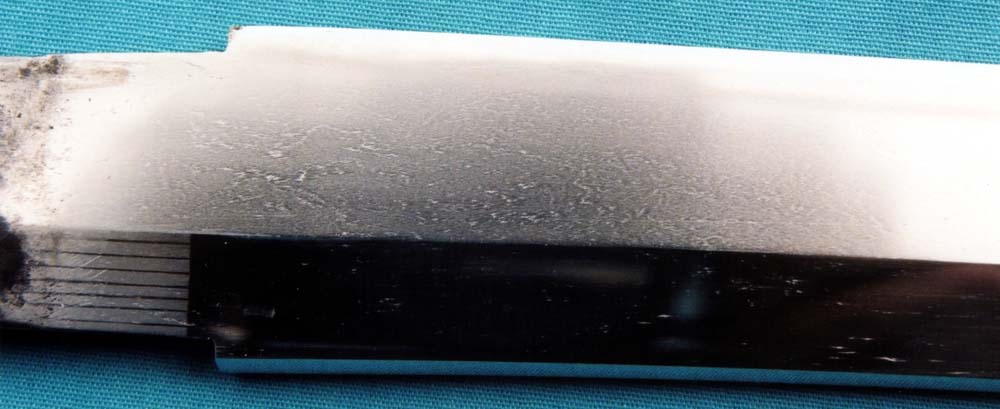 |
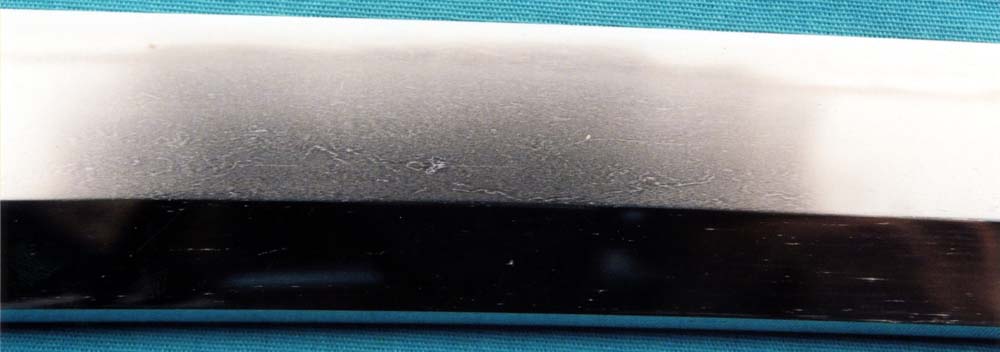 |
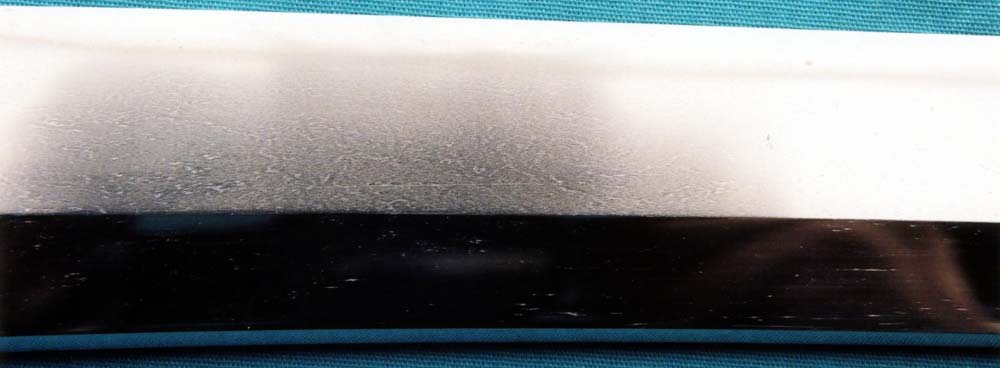 |
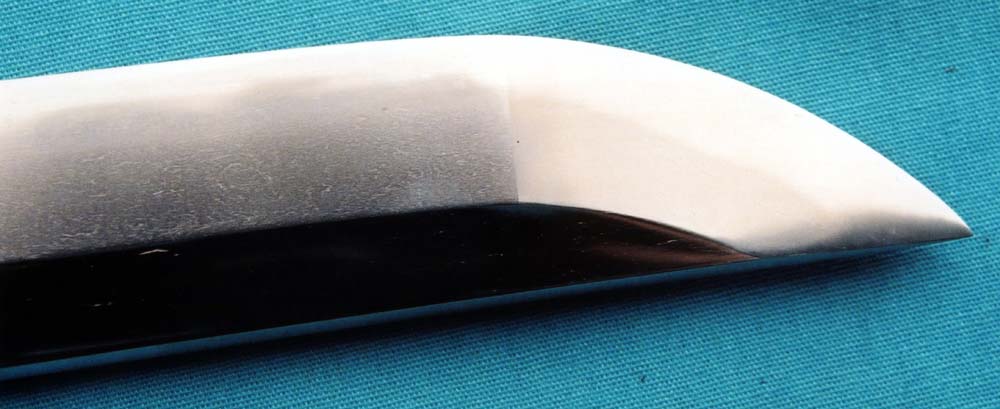 |
GRAIN PATTERN
The actual HADA pattern can be combinations of the following:
| MASAME - KO-MASAME - O-MASAME - |
Straight-like grain pattern Small straight pattern Large straight pattern |
| ITAME - KO-ITAME - O-ITAME - |
Wood "grain like a board" Small wood pattern Large wood pattern |
| MOKUME - KO-MOKUME - O-MOKUME - |
Burl-like grain pattern Small burl pattern Large burl pattern |
| AYASUGI - | Flowing Cedar. Large undulating wave grain pattern |
| NASHIJI - | Flesh of a Pear pattern Condition of very finely worked HADA |
| MUJI - | No grain |
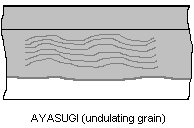 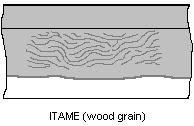 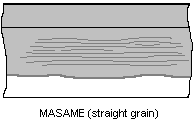 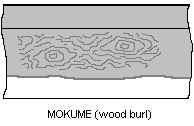
|
The terms may be seen used short, MASA, ITA, MOKU as, "O-ITA KO-MOKU mix." This is generally improper, however.
O-HADA is a large grain pattern or an individually large area of grain. These might be called UZU, swirling cloud or whirlpool.
YUBASHIRI is a term used to describe the swirling condition of a certain form of running HADA. The term YUBASHIRI means "running water" and is also used for swirling or wisp-like features of the hardened edge pattern, or YAKIBA.
When a grain pattern appears drawn-out it may be labeled, "running," "flowing," or "streaming."
Sword descriptions may note HADA as being "pronounced" or "standing out."
| NOTE: Some publications use "ITAME" to denote the presence of patterned grain or to describe any grain pattern other than straight-grain, MASAME, or no grain, MU-JI. Occasionally, one finds auction or museum pamphlets confusing "ITAME" for patina, a misunderstanding. Grain pattern may actually be MOKUME or combinations. |
TEMPER PATTERN
The line of the famous temper pattern of the Japanese Sword is called the HAMON. The whole of the hardened edge portion, for which the HAMON is the outline, is the YAKIBA or "fired-edge."
The line of HAMON in the KISSAKI area is the BOSHI or "hat."
The area of YAKIBA rising from the HA-MACHI, just above the NAKAGO) is called YAKIDASHI. YAKIDASHI means "beginning YAKIBA" and, especially in pieces of the SHINTO period, can be an area where the HAMON starts out rather devoid of pattern.
Technical descriptions use YAKIBA, while on the plane of the JI, to be considered for itself, separate from the JI. The term JI-HADA is often used to describe the grain pattern of the JI, either as a whole or specifically outside the YAKIBA.
If there is hardening or temper pattern on the back of the blade, it is referred to as MUNE-YAKI.
The intricacies of HAMON an YAKIBA were not created by accident, nor are they the product of one genius. The original inspiration is debatable but every smith learned sword making from the industry contemporary to his time which, in Japan, meant labor at the forge of a teacher.
It was only the successive contributions of driven lives, teacher from teacher, that brought the "Way" for perfection in school style and individual technique.
The specific method in which carbon was folded into iron allowed the resultant carbon-bonding to differentiate hard crystalline steel from soft at the quench. Differentiation was the source of the myriad form, color and shape we see as the intricacy of YAKIBA and its line of HAMON.
The developed "Way" of sword making and specifically the method of quench gave a school its style of YAKIBA and HAMON.
Quality, form, and color. Excellence was the constant drive and, in this, most work was eminently successful. Japanese Swords were history's greatest artistic achievement in steel and weaponry.
YAKIBA
The HAMON consists of two basic constituents, NIE and NIOI.
NIE are globules of crystalline steel differentiated from soft. When present, NIE can be clearly seen. In the lesser work it may appear as splotchy patches or as if it were droplets of spray. NIE in the better work is more defined and color-rich. Its hardness often resists the polishers' stone in such a way that it can appear, and in fact remains, rounded and slightly protruding from the surface. In some work it can appear gem-like and as if "floating" in its sea of folded steel. MURA-NIE is profuse NIE.
NIOI is crystalline steel as well, but the term means "Scent." NIOI appears like a white or silver mist or vapor. NIOI has been referred to as "white cloud" and usually defines the HAMON.
NIOI-DEKI means "finished in NIOI."
Crystalline steel can form straight, curved or arcing, sometimes color-rich lines called KINSUJI "Golden Line," or GINSUJI "Silver Line." There are similar lines often found in YAKIBA that run parallel like "Waves of Sand," called SUNAGASHI.
INAZUMA "Flashes of Lightning" has been called Violet Lightning. These can arc into the JI.
CHIKEI are lines that appear in the JI. They may appear dark and are places where the folding method wrought HADA to reveal line-shaped forms of carbon-rich steel. These lines also may or may not "take temper."
TOBI or TOBI-YAKI are round-shaped patches or islands, often NIE-rich, that appear in the JI attendant to the HAMON. They may appear to "jump up" or "dart up" from the HAMON.
HOTSURE means "strays" and describes drifts that leave the line of HAMON. They may look like wind-pulled clouds clinging to the horizon. Strays into the YAKIBA are also called HOTSURE.
YO means "leaves." These can be "blown leaves," "falling leaves" or "fallen leaves" and are small dot-like formations of NIOI within the YAKIBA. Dots. Grouped dots or dots attending CHOJI BA.
YAKI-KUZURE or "Crushed YAKIBA" can refer to openings that cause island-like shapes in the HAMON.The term is used to describe large or small forms separated, or appearing to be torn, from the HAMON and can appear much like broken ice-floes or ice that is breaking up. YAKI-KUZURE can be similar to a map overview of continental drift. -Patches broken out along a horizontal crevice or on fiord-like openings of the HAMON.
YUBASHIRI can appear as cloud-wisps. Application of this term has been evoked for shapes caused either by style of HAMON or the interactions of sword laminate structure at the quench. YUBASHIRI means running or boiling water, and has been used to describe the swirling appearance of a certain form of running HADA as well.
ASHI "legs" is NIOI that falls from the HAMON toward the HA, or cutting edge, often from the trough of a valley. ASHI may appear as notches in the line. Small radiating ASHI, or the radiating ends of longer ASHI, can appear similar to little clawed feet and when seen are called NEZUMI or NEZUMI-ASHI "Rat's Feet."
One of the most beautiful and rare NIOI forms is UTSURI, or "Reflections." This was created by temperature differential at the quench. Perfected by the ICHIMONJI, UTSURI has been called the "ghost temper" and is a mist or vapor-like reflection of the HAMON. It appears across the JI and SHINOGI-JI sections of the blade.
NIJUBA "Two-fold HA" refers to double HAMON. This effect is said to have been perfected, as a matter of purposeful technique, by few smiths.
TEMPER LINES
The "Way" of manufacturing technique brought a precise manifestation of YAKIBA and HAMON. The way NIE and NIOI interplay in a common theme of temper line, as produced in a given smith's work, was not happenstance but a matter of pursuit. Individual YAKIBA styles have long been cataloged and are one of the main definers of origin.
Sword schools and their individual masters, therefore, have signature YAKIBA styles that are initially identified by HAMON.
A long straight HAMON line is called SUGU-HA (straight HA). If there are slightly irregular undulations, the description is expanded to SUGU KO-MIDARE (straight small-uneven).
If the HAMON is composed of irregular patterns it is called MIDARE. Irregular patterns are KO-MIDARE if they are small.
The following are descriptive elements used and expanded upon in the above manner to denote particular HAMON patterns or style.
SUGU - A straight pattern CHOJI - Clove blossom pattern MIDARE - Uneven patterns JUKA - CHOJI laid over CHOJI GUNOME - Round-shaped OBUSA - High CHOJI rises SUDARE - Bamboo blinds KAWAZU - "Tadpole" CHOJI SAKA - Slanted KOBUSHI - "Fist" CHOJI TORAN - High waves YA-no-NE - Arrowhead HAKO - Box pattern MIMIGATA - Ear-shaped NOKO - Sawtooth HITATSURA - Full-temper UMA - Horse teeth SANBONSUGI - "Three-cedars" NOTARE - Waves ASAKI-NOTARE - Shallow waves
The terms are used in combination and with such prefixes as HIRO "wide", CHU "medium", HOSO "thin", O "large" or KO "small." When applicable they can be followed with MIDARE "uneven", KUZURE crushed, and others. Hence "O-CHOJI MIDARE" indicates "uneven large clove-blossom" forms.
There are, additionally, terms such as HAKIKAKE "sweepings of a broom," KAEN "flame" and TOGARI "pointed" which are used for HAMON but are also used in describing BOSHI (hardening in the KISSAKI).
Note: Line or "ground"
terms
It is not commonly understood, but important to remember that
the terms SUGU, MIDARE and NOTARE, while used loosely for
their particular types of YAKIBA and HAMON patterns, are also constantly used a
little differently in Japanese texts. A misinterpritation has been copied
repeatedly into English and left the English-speaking community with rather
poorly defined descriptive vocabulary.
When SUGU is used, as in SUGU KO-CHOJI, it means that KO-CHOJI HAMON patterns flow on a fairly straight line along the sword edge.
Likewise, when NOTARE is used, it means the HAMON pattern, which ever that pattern happens to be, is undulating on a wave like line down the sword edge.
So HAMON terms may be specific patterns or also they may be denoting the shape of the line on which the HAMON pattern sits.
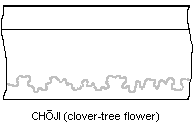 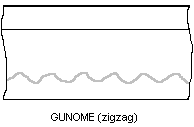 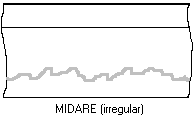 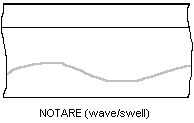 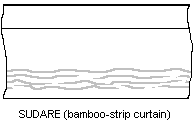 |
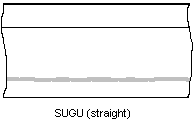 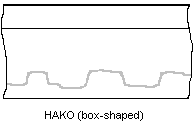 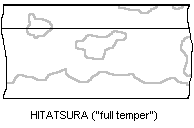 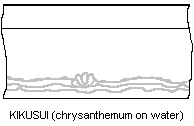 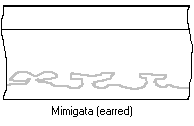 |
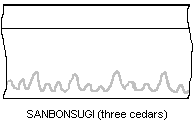 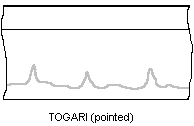 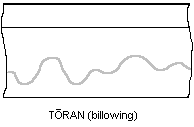 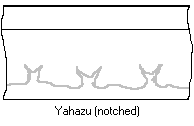
|
Line or "ground" terms
SUGU Fairly even flowing line KO-MIDARE A pattern that flows a slightly uneven course MIDARE Unevenly flowing pattern NOTARE The pattern undulates down the blade ASAKI-NOTARE The pattern rises and falls on gentle swells KO-NOTARE Same, slight rise and fall
BOSHI are often described simply with a single term. Since BOSHI either has pattern or is smooth "SUGU", the terms KO-MARU "small-round", O-MARU "large-round", HAKIKAKE or KAEN suffice as a short-hand description. However the BOSHI is one of the most important parts of the sword and an accurate description always involves the area of pattern at the YOKOTE, the pattern and amount of YAKIBA along the sweep of the FUKURA, the actual top of BOSHI, area closest to the point, and the turnback or KAERI.
The BOSHI is important because, as it was at the height of the smith's intention, its unique style components are a main key in classification.
There are times in appraisal when BOSHI is the deciding factor.


 |



|
The above 'guide' gives credit to Sho-shin, and Richard Stein's Japanese Sword Guide web sites.
| Return to Gallery or Study Guide Email to Shibui Swords |